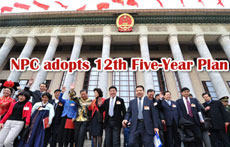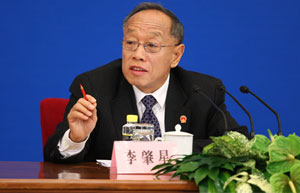Full text: Report on China's economic, social development plan
(Xinhua)
Updated: 2011-03-18 15:00
3. Economic restructuring was carried out vigorously.
China's capacity for independent innovation increased. Good progress was made in implementing 16 key state science and technology programs together with the March 1997 Program for Basic Research, the March 1986 High-Tech Program and the National Key Technology R&D Program. Construction on the Shanghai Synchrotron Radiation Facility, the National Center for Nanoscience and Technology and other major science projects was completed and passed acceptance inspection. The third phase of the Knowledge Innovation Program in the Chinese Academy of Sciences was basically completed. Smooth progress was made in carrying out major projects such as building 50 national engineering centers, 32 national engineering laboratories and 56 key national laboratories seated in enterprises in areas such as digital television and next-generation Internet, as well as manufacturing advanced-generation LCD panels, large-scale integrated circuits and regional aircraft. Further progress was made in the development of large aircraft. An additional 93 enterprise technology centers received state recognition, 550 enterprises were now included in the national pilot program to support innovative enterprises, and the national pilot projects for innovation-oriented cities were carried out in 45 cities. The calculating speed of the high performance Tianhe-1 supercomputer, which was developed independently, is ranked first in the world.
High-tech industries developed more quickly. The value-added of the high-tech manufacturing industry for the year rose 16.6%, up 8.9 percentage points from the previous year. The output of major high-tech products increased considerably, with output of integrated circuits growing by 57.4%, electronic components by 30.1%, microcomputers by 35% and mobile telecommunication handsets by 46.4%; and the sales of software came to 1.3 trillion yuan, up 30%. Trade volume in the technology market exceeded 300 billion yuan. We promulgated and implemented the Decision on Accelerating the Cultivation and Development of Strategic Emerging Industries; actively moved forward with seven projects to apply high technology to production, including the project to promote modern practices in traditional Chinese medicine; built 18 national high-tech industrial bases; and set up 13 venture capital funds.
Fresh progress was made in industrial restructuring. We continued to implement the plan for restructuring and invigorating key industries, allocated a fund of 20 billion yuan for invigorating such industries and upgrading their technologies, and supported 5,051 technological upgrading projects. The relocation of the Shougang Group was completed smoothly, and substantive progress was made in reorganizing the Angang Steel Company Ltd. and the Pangang Group Company Ltd. We promulgated and implemented guidelines on accelerating the restructuring of the pharmaceutical industry. We completed all tasks of closing down backward production facilities. We shut down such facilities at thermal power plants with a total capacity of 12.1 million kilowatts, 2.1 million kilowatts more than planned; steel mills of 9.31 million tons, 3.31 million tons more than planned; iron foundries of 40 million tons, 15 million tons more than planned; cement plants of 116.19 million tons, 66.19 million tons more than planned; plate glass plants of 552,500 tons, 252,500 tons more than planned; and paper mills of 4.72 million tons, 4.19 million tons more than planned.
The service sector developed steadily. We launched trials of comprehensive reforms in the service sector, used funds for guiding development of the service sector to help accelerate the development of key areas and weak links of the sector, and promulgated and implemented guidelines on promoting development of the energy conservation service industry. In 2010, the service sector constituted 34.8% of the country's employment, and the value-added of the sector accounted for 43% of GDP.
(Figure 6: Value-added of the Service Sector in the Eleventh Five-Year Plan Period)
Infrastructure and basic industries became better able to meet demands made on them. Nationwide, 4,986 kilometers of railway lines were put into operation, raising the total to 91,000; 120,000 kilometers of highways were opened to traffic, raising the total to 3.98 million; 500 kilometers of high-grade inland waterways were opened to navigation, raising the total to 10,000; 125 deepwater seaport berths were put into service, raising the total to 1,774; and 9 new civilian airports were put into service, raising the total to 175. Some 1.66 million kilometers of optical cables were installed, raising the total to 9.95 million kilometers; and 49.24 million broadband Internet access ports were opened up, raising the total to 188 million. We intensified the construction of key energy projects, energy bases, and storage and transportation facilities. Eleven out of 13 large coalmining bases have already reached a production capacity of 100 million tons. A number of clean-energy projects were completed and put into operation; construction of the second phase of the state petroleum reserves project was accelerated; and total power transmission capacity of the northern, central and southern routes of the project to send electricity from the west to the east exceeded 78 million kilowatts. The annual output of raw coal was 3.24 billion tons, up 8.9%; crude oil output was 203 million tons, up 7.1%; natural gas output reached 96.76 billion cubic meters, up 13.5%; and electricity generation totaled 4.2065 trillion kilowatt-hours, up 13.2%.
Regional development became better balanced. We deepened the implementation of the overall strategy for regional development, and promulgated and implemented the national plan for development priority zones.
We smoothly introduced the guidelines on thoroughly implementing the strategy for large-scale development of the western region; promulgated and implemented the guidelines on promoting leapfrog development and long-term stability of Tibet and Xinjiang as well as on accelerating the development of Tibetan ethnic areas in Sichuan, Yunnan, Gansu and Qinghai; and approved the establishment of the Liangjiang New Area in Chongqing. Construction began on another 23 major projects for the large-scale development of the western region, with total investment reaching 682.2 billion yuan.
We increased support for optimizing and upgrading the industrial structure and developing modern service industries in northeast China, formulated the guidelines on supporting the region in developing modern agriculture, and further improved the policy framework for sustainable development of resource-dependant cities.
We fully implemented the plan to energize the development of the central region, accelerated the development of three different types of production bases and a system of integrated transportation hubs in the region, and introduced the guidelines on promoting the development of city clusters in the central region as well as the plan to establish demonstration zones for relocating industries to the central region in the city cluster along the Yangtze River in Anhui. The Wuhan metropolitan area; the Changsha-Zhuzhou-Xiangtan city cluster; city clusters in the central plains; the Poyang Lake Ecological Economic Zone; and the city cluster around Taiyuan in Shanxi, all played a bigger role in driving the development of their surrounding areas. Further progress was made in relocating industries to the central and western regions.
We actively promoted upgrading of the industrial structure and independent innovation in the eastern region; accelerated reform and opening up in Shenzhen and other special economic zones, the Pudong New Area in Shanghai and the Binhai New Area in Tianjin; promulgated and implemented the plan to stimulate the development of the Yangtze River Delta; and launched the national pilot program to develop the marine economy.
More support was given to old revolutionary base areas, ethnic minority areas, border areas and poverty-stricken areas. In 2010, the central government arranged 5.5 billion yuan for investment in work-relief schemes and a fund of 2 billion yuan on the pilot project to relocate people from inhospitable areas as a poverty relief measure. As a result, 870,000 people were relocated, 110,000 more than planned; and over 9.09 million rural residents were lifted out of poverty, basically reaching the target.



